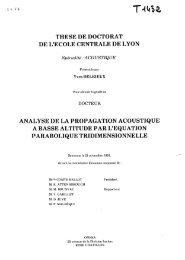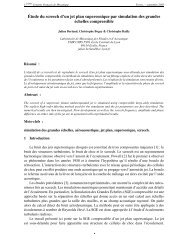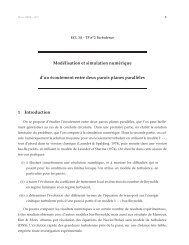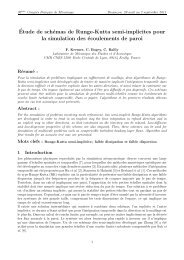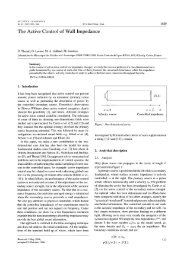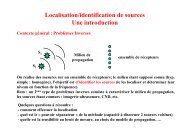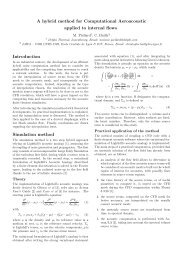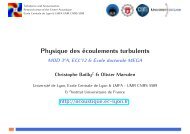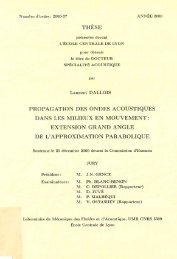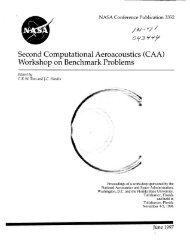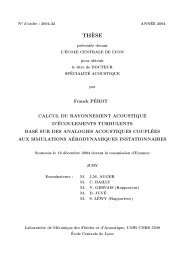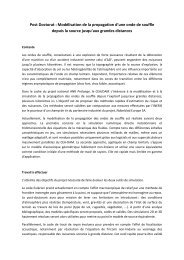On the radiated noise computed by large-eddy simulation
On the radiated noise computed by large-eddy simulation
On the radiated noise computed by large-eddy simulation
Create successful ePaper yourself
Turn your PDF publications into a flip-book with our unique Google optimized e-Paper software.
Phys. Fluids, Vol. 13, No. 2, February 2001 <strong>On</strong> <strong>the</strong> <strong>radiated</strong> <strong>noise</strong> <strong>computed</strong> <strong>by</strong> <strong>large</strong>-<strong>eddy</strong> <strong>simulation</strong><br />
FIG. 7. Comparison between acoustic pressures respectively associated to<br />
<strong>the</strong> filtered Lighthill tensor and <strong>the</strong> resolved Lighthill tensor<br />
on 32 3 grid.<br />
of <strong>the</strong> acoustic spectrum <strong>the</strong> condition /L0.471/St is<br />
required, for this grid (16 3 )/L0.4 is obtained indicating<br />
that <strong>the</strong> smallest resolved eddies are very close to those associated<br />
to <strong>the</strong> peak of <strong>the</strong> acoustic spectrum.<br />
When <strong>the</strong> subgrid scale effects representing <strong>the</strong> interaction<br />
between <strong>the</strong> resolved and <strong>the</strong> unresolved structures are<br />
not taken into account, <strong>the</strong> results obtained are very far from<br />
<strong>the</strong> solution <strong>computed</strong> from <strong>the</strong> low frequency part of <strong>the</strong><br />
acoustic source term. The <strong>large</strong>st error is observed as expected<br />
for <strong>the</strong> lowest value of k c i.e., 16 3 used for <strong>the</strong><br />
<strong>simulation</strong>. <strong>On</strong> <strong>the</strong> 32 3 grid mesh representation presented in<br />
Fig. 7, <strong>the</strong> subgrid contribution is still significant. Errors occur<br />
for both amplitude and phase of <strong>the</strong> acoustic signal indicating<br />
an important effect of <strong>the</strong> subgrid scale.<br />
The comparison between acoustic spectra of <strong>the</strong> quantity<br />
(p/p ref) 2 where p ref is <strong>the</strong> amplitude of <strong>the</strong> peak of <strong>the</strong> spectrum<br />
for DNS case and <strong>the</strong> pressure p is <strong>computed</strong> from <strong>the</strong><br />
full Lighthill tensor and from <strong>the</strong> resolved one is presented in<br />
Fig. 8. Important discrepancies concerning acoustic spectrum<br />
<strong>computed</strong> on 16 3 and 32 3 grids occur while <strong>the</strong> solution on<br />
FIG. 8. Comparison between acoustic spectra <strong>computed</strong> from: <strong>the</strong> full<br />
Lighthill tensor ; <strong>the</strong> resolved Lighthill tensor on 16 3 , on<br />
32 3 ••••, on64 3 • • • grids.<br />
FIG. 9. Comparison between energy spectrum <strong>computed</strong> from DNS data:<br />
E(k) and energy spectrum associated to <strong>the</strong> filtered Lightill tensor<br />
E(k)G 2 (k) on 16 3 nodes; • ••• 32 3 nodes; • • • 64 3<br />
nodes.<br />
64 3 nodes remains close to <strong>the</strong> DNS result. As <strong>the</strong> filtered<br />
Lighthill tensor allows to recover <strong>the</strong> behavior expected <strong>by</strong><br />
Proudman’s <strong>the</strong>ory, <strong>the</strong> resolved Lighthill tensor does not for<br />
<strong>the</strong> two lowest values of k c as shown in Fig. 8. In <strong>the</strong> frequency<br />
range St2,6 where Proudman’s model was recovered,<br />
<strong>the</strong> acoustic spectrum decreases more rapidly when <strong>the</strong><br />
resolved Lighthill tensor is used for <strong>the</strong> computation. Moreover<br />
<strong>the</strong> peak of <strong>the</strong> acoustic spectrum for <strong>the</strong>se two cases<br />
has been shifted to <strong>the</strong> lowest frequency leading now to St<br />
1.8 for <strong>the</strong> 16 3 case and a 2.0 for <strong>the</strong> 32 3 case while St<br />
2.15 was expected Fig. 8. As suggested <strong>by</strong> <strong>the</strong> intensity<br />
ratio I LES /Ī0.91 on <strong>the</strong> 64 3 grid <strong>the</strong> acoustic spectrum remains<br />
close to <strong>the</strong> DNS one. When a LES is performed <strong>the</strong><br />
resulting kinetic energy spectrum is <strong>computed</strong> as a function<br />
of u iu jG ˆ 2 . These spectra are presented in Fig. 9 showing<br />
that <strong>the</strong> inertial range is still <strong>the</strong>re for cutoff wave number<br />
values considered. As <strong>the</strong> decay of Eulerian time correlations<br />
was dominated <strong>by</strong> <strong>large</strong> scale straining according to Zhou<br />
et al., 36 <strong>the</strong> use of <strong>the</strong> resolved Lighthill tensor does not recover<br />
reliable results indicating that <strong>the</strong> subgrid scale tensor<br />
should be parametrized in both cases 16 3 and 32 3 mesh grid<br />
to get reliable results for <strong>the</strong> acoustic field.<br />
C. Parametrization of <strong>the</strong> Lighthill subgrid scale<br />
tensor<br />
483<br />
In order to recover reliable results concerning both<br />
acoustic intensity and Strouhal number when LES and Lighthill’s<br />
tensor are used toge<strong>the</strong>r, a parametrization of <strong>the</strong> subgrid<br />
Lighthill tensor must be performed. Two models have<br />
been tested for <strong>the</strong> compressible case: 17 a subgrid scale<br />
model of <strong>eddy</strong> viscosity type, like <strong>the</strong> Smagorinsky model 38<br />
and a scale similarity type model, like <strong>the</strong> Bardina<br />
model. 39,40 The Bardina model led to better results than <strong>the</strong><br />
Smagorinsky model and for <strong>the</strong> present <strong>simulation</strong>s scale<br />
similarity models have been retained. Subgrid Lighthill’s<br />
tensor parametrization with Bardina’s model has been chosen<br />
leading to<br />
Downloaded 17 Mar 2003 to 156.18.39.49. Redistribution subject to AIP license or copyright, see http://ojps.aip.org/phf/phfcr.jsp



